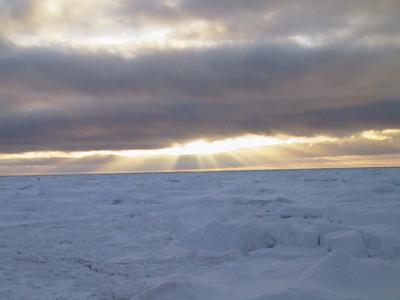
|
|
17 March, 2000
I Saw It With My Own Eyes
74 22 s, 104 37 w
Midway between Canisteo Peninsula and Thwaites Glacier Tongue, northwest of
Pine Island Glacier
Temp 3.8 C (25 F), 8 knot (9 mph) NW wind
Barometer 985 mb and rising
On CTD station, in open water next to large field of brash ice
Tonight at last there are a few stars out. Through occasional
holes in the overcast I see the Southern Cross, and then moments later the
two pointer stars. The clouds are thin, and I can see the top edges of them
lit up in greenish light, either by the nearly full moon or the Aurora
Australis, I'm not sure which. I go into the bridge and watch the
spotlights probe the dark ice free sea ahead. My eyes have no references
for depth or shape, not even snowflakes swirling in the beams. Suddenly I
see what looks like a vertical white spotted wall in the darkness ahead. As
we steam towards it, it seems to get taller, until it fills up half our
view. It looks taller than the ship. The whole scene is right out of a Star
Trek episode. Then I glance over to the radar screen and the picture makes
sense again. We're approaching a loose field of white brash and growler
ice. The ship sails harmlessly into and through the wall, with occasional
thuds as we hit the larger pieces.
Later the moon sets, and is partially visible for a short time. It
casts its light on the mist and the icebergs, and for a brief time there is
an unworldly landscape in blue and white. Snow petrels glide continuously
about the ship, skimming the wake for food brought to the surface in the
turbulence of the propellers. Once in a while the birds flash through the
spotlights. I have work to do, but hate to take my eyes off the world
around the ship.
Out on the dark part of the bridge deck I watch the stars again.
The Nathaniel B. Palmer has a tall mast amidships for lights and antennas.
You can see the steel mast +in one of the pictures with my March 16 journal
entry. As I look up, all I see are the stars and this mast. All of a
sudden, the whole star field starts slowly turning around the mast. Perhaps
I'm not getting enough sleep! But then I realize the cause; the ship has
slowly and smoothly altered course. The stars are stationary, the mast is
moving.
Optical illusions are fun and they show how dependent the brain is
on some sort of familiar object in the visual field. Without some
reference, be it a seal, a Zodiac or a penguin in the distance, the brain
simply can't make sense of what the eyes are seeing. This has been my
trouble since I got to Antarctica, and is the same difficulty early
explorers mention. When I look at scenery, it is very difficult to judge
distances, or even tell snowfields from sky. I often have to stare for a
few moments to understand what I see. Things do make better sense than they
did the first few days, though.
The work of the Nathaniel B. Palmer, and my small part in it, goes
on seven days a week, twenty four hours each day. Last night we cored three
times, mapped several hundred square kilometers of bottom, did three CTDs,
an ice station, and seal observations. Because of the depth of 1500 m (4920
ft.), it takes almost an hour for the corer to reach bottom and come back
up. After it's on the surface, we have another one to two hours of
sampling, labeling, storage and cleanup to do. It is repetitive but crucial
work. The cores we are gathering will be examined in labs over the next few
years. A lost or unclear label makes a sample useless for scientific purposes.
We are exploring the deeply gouged out glacial trough where 15,000 years
ago (and probably more recently) massive ice streams from the Pine Island
and Thwaites Glaciers merged to flow towards the continental shelf edge.
The SeaBeam keeps painting underwater hills and canyons for us, a mile
below. We fill in empty places on the blank chart, but know many will
remain blank when we leave. Some places are covered with ice to thick for
the Nathaniel B. Palmer; we won't have time for others. It will be a long
time before the waters around Antarctica are thoroughly mapped, and longer
still before the land hidden under the ice cap is known.
Now that we are two thirds of the way through our exploration, many aboard
are starting to think of home. I know I am.
There is still much ahead of us, though, two more weeks at sea. There is
more work here, then transit of the Bellingshausen Sea, the trip up the
west side of the Antarctic Peninsula, a visit to Palmer Station, the Drake
Passage, the Straits of Magellan, and Puentas Arenas. I'm looking forward
to all of it.

Sally Mathieu tests samples for chloroflourocarbons (CFCs) with a gas chromatograph. I'll tell you about her and her lab mate Synte Peacock and the work they are doing in another entry.

The noon sun peaks through a hole in the clouds. It never gets very high in the sky here.

It's hard to keep up appearances at four in the morning. My watchmates Jesse Johnson (left) and Dan Naber work on a Kasten core.
Contact the TEA in the field at
.
If you cannot connect through your browser, copy the
TEA's e-mail address in the "To:" line of
your favorite e-mail package.
|
